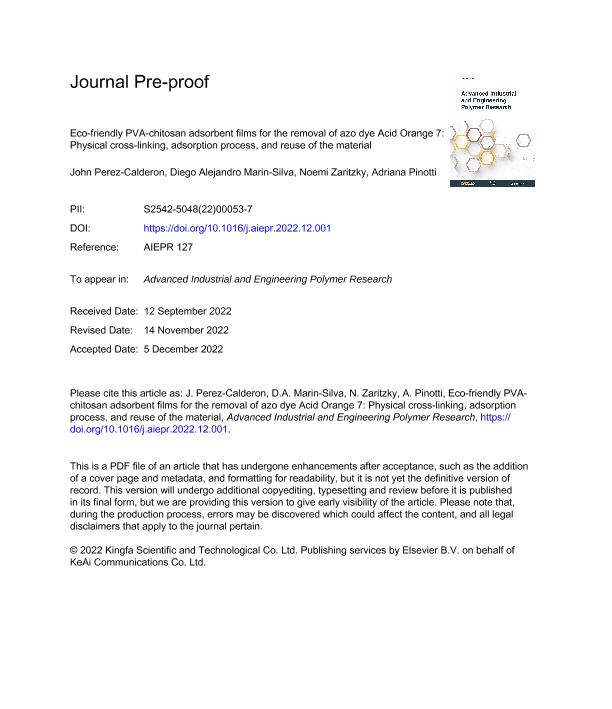Mostrar el registro sencillo del ítem
dc.contributor.author
Perez Calderon, John Freddy

dc.contributor.author
Marín Silva, Diego Alejandro

dc.contributor.author
Zaritzky, Noemi Elisabet

dc.contributor.author
Pinotti, Adriana Noemi

dc.date.available
2023-07-25T11:59:05Z
dc.date.issued
2023-07
dc.identifier.citation
Perez Calderon, John Freddy; Marín Silva, Diego Alejandro; Zaritzky, Noemi Elisabet; Pinotti, Adriana Noemi; Eco-friendly PVA-chitosan adsorbent films for the removal of azo dye Acid Orange 7: Physical cross-linking, adsorption process, and reuse of the material; Elsevier; Advanced Industrial and Engineering Polymer Research; 6; 3; 7-2023; 239-254
dc.identifier.issn
2542-5048
dc.identifier.uri
http://hdl.handle.net/11336/205182
dc.description.abstract
The treatment of wastewater requires the use of eco-friendly and cost-efficient adsorbents. A hybrid adsorbent film based on biodegradable polymers (poly(vinyl alcohol) (PVA) and chitosan (Ch) was developed to remove Acid Orange 7 (AO7), an azo dye from the textile industry present in industrial wastewaters. The polymeric absorbent material was submitted to a curing process with different time-temperature combinations which improved its physical stability in aqueous media. This result was supported by modulated differential scanning calorimetry (MDSC) and thermogravimetric analysis (TGA). ATR-FTIR also confirmed the electrostatic interactions by hydrogen bonds between PVA and Ch, as well as among the polymers and the dye. The best curing condition to reach a high removal without weight loss was the combination of 160°C-1h. Dye adsorption depended mainly on pH, adsorbent dose, contact time, temperature, and coexisting anions. The maximum removal efficiency (>91%) was achieved at pH = 2.5. The adsorption kinetics followed the Lagergren pseudo first-order rate equation and the adsorption isotherm was best described by the Redlich-Peterson model. As far as the authors know, the maximum adsorption capacity (Qm) of the adsorbent film obtained in the present work is the highest value reported in literature (Qm = 678 mg/g at 298 K and pH = 2.5). Physisorption would be the dominant mechanism at pH 4.0 while at pH 2.5 the process was conducted by chemisorption. Regeneration studies showed that composites could be used for five consecutive cycles without losing their adsorption capacity. Thus, the use of the developed eco-compatible biodegradable materials would allow easy regeneration without losing removal selectivity, a key feature in the development of environmentally friendly sorbent materials.
dc.format
application/pdf
dc.language.iso
eng
dc.publisher
Elsevier

dc.rights
info:eu-repo/semantics/openAccess
dc.rights.uri
https://creativecommons.org/licenses/by-nc-nd/2.5/ar/
dc.subject
AZO DYE
dc.subject
BIOSORBENT
dc.subject
CHITOSAN
dc.subject
HYBRID FILM
dc.subject
PHYSICAL CROSS-LINKING
dc.subject
PVA
dc.subject.classification
Recubrimientos y Películas

dc.subject.classification
Ingeniería de los Materiales

dc.subject.classification
INGENIERÍAS Y TECNOLOGÍAS

dc.title
Eco-friendly PVA-chitosan adsorbent films for the removal of azo dye Acid Orange 7: Physical cross-linking, adsorption process, and reuse of the material
dc.type
info:eu-repo/semantics/article
dc.type
info:ar-repo/semantics/artículo
dc.type
info:eu-repo/semantics/publishedVersion
dc.date.updated
2023-07-07T18:34:14Z
dc.journal.volume
6
dc.journal.number
3
dc.journal.pagination
239-254
dc.journal.pais
China

dc.description.fil
Fil: Perez Calderon, John Freddy. Provincia de Buenos Aires. Gobernación. Comisión de Investigaciones Científicas. Centro de Investigación y Desarrollo en Criotecnología de Alimentos. Consejo Nacional de Investigaciones Científicas y Técnicas. Centro Científico Tecnológico Conicet - La Plata. Centro de Investigación y Desarrollo en Criotecnología de Alimentos. Universidad Nacional de La Plata. Facultad de Ciencias Exactas. Centro de Investigación y Desarrollo en Criotecnología de Alimentos; Argentina
dc.description.fil
Fil: Marín Silva, Diego Alejandro. Provincia de Buenos Aires. Gobernación. Comisión de Investigaciones Científicas. Centro de Investigación y Desarrollo en Criotecnología de Alimentos. Consejo Nacional de Investigaciones Científicas y Técnicas. Centro Científico Tecnológico Conicet - La Plata. Centro de Investigación y Desarrollo en Criotecnología de Alimentos. Universidad Nacional de La Plata. Facultad de Ciencias Exactas. Centro de Investigación y Desarrollo en Criotecnología de Alimentos; Argentina
dc.description.fil
Fil: Zaritzky, Noemi Elisabet. Provincia de Buenos Aires. Gobernación. Comisión de Investigaciones Científicas. Centro de Investigación y Desarrollo en Criotecnología de Alimentos. Consejo Nacional de Investigaciones Científicas y Técnicas. Centro Científico Tecnológico Conicet - La Plata. Centro de Investigación y Desarrollo en Criotecnología de Alimentos. Universidad Nacional de La Plata. Facultad de Ciencias Exactas. Centro de Investigación y Desarrollo en Criotecnología de Alimentos; Argentina. Universidad Nacional de La Plata. Facultad de Ingeniería. Departamento de Ingeniería Química; Argentina
dc.description.fil
Fil: Pinotti, Adriana Noemi. Provincia de Buenos Aires. Gobernación. Comisión de Investigaciones Científicas. Centro de Investigación y Desarrollo en Criotecnología de Alimentos. Consejo Nacional de Investigaciones Científicas y Técnicas. Centro Científico Tecnológico Conicet - La Plata. Centro de Investigación y Desarrollo en Criotecnología de Alimentos. Universidad Nacional de La Plata. Facultad de Ciencias Exactas. Centro de Investigación y Desarrollo en Criotecnología de Alimentos; Argentina. Universidad Nacional de La Plata. Facultad de Ingeniería. Departamento de Ingeniería Química; Argentina
dc.journal.title
Advanced Industrial and Engineering Polymer Research
dc.relation.alternativeid
info:eu-repo/semantics/altIdentifier/url/https://linkinghub.elsevier.com/retrieve/pii/S2542504822000537
dc.relation.alternativeid
info:eu-repo/semantics/altIdentifier/doi/http://dx.doi.org/10.1016/j.aiepr.2022.12.001
Archivos asociados
